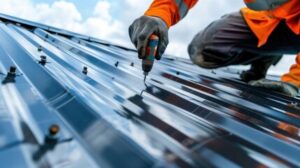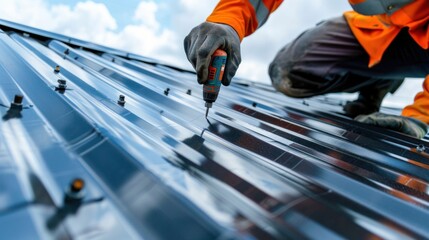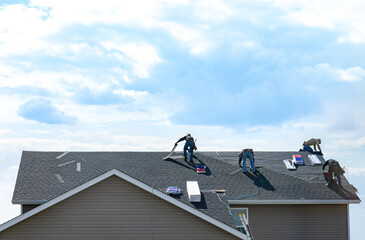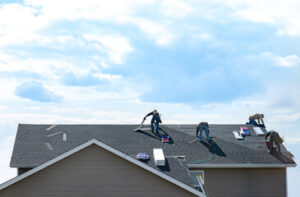The roof is one of the most vulnerable areas in a home. Without regular maintenance, it can develop major damage and compromise structural integrity.
Look for rust, gaps, cracks, and leaks. Also examine flashing around penetrations like chimneys and skylights. Also, check the caulking. Cracked caulking is a major cause of water leaks. Click Here for more details.
In the business world, maintaining commercial roofs is an important task that affects a building’s overall profitability. Regular inspections and timely repairs ensure the longevity of the roof, reducing repair and replacement costs. Additionally, they prevent leaks and structural damage that can lead to business disruptions. Finally, they also improve energy efficiency, reducing heating and cooling expenses, which are a significant component of operational costs for most businesses.
Costs associated with roof maintenance vary considerably based on the scope of work and the materials required for the repair. For example, simple repairs such as replacing a few damaged shingles are usually less expensive than repairing extensive leaks and addressing structural issues like rotting wood or excessive water infiltration. Moreover, the size of the roof influences maintenance costs, as larger roofs require more materials and labour. In addition, unforeseen expenses such as the need for additional structural reinforcement or the discovery of more extensive damage can increase repair costs.
Leak repairs often involve removing and replacing shingles, patching holes, and resealing the entire roof. This can be costly, especially if the leak is caused by severe weather damage or by an issue with the roof’s flashing. The flashing is a sheet of metal that seals gaps around roof penetrations such as chimneys, skylights, and vents. It is critical to maintain the integrity of the flashing to prevent water infiltration and other structural problems.
Investing in routine roof maintenance can save homeowners money in the long run. Many roofing issues only become serious and require costly repairs when they are left unchecked for a long time. Routine inspections and timely repairs can detect and address these issues before they deteriorate into significant problems. Ultimately, a well-maintained roof is a wise investment that protects the value of the home.
It’s essential to understand the cost breakdown of roof maintenance to make informed decisions regarding your budget. You should also consider partnering with independent roofing experts to elevate your proactive maintenance strategy. They can help you find qualified roofing contractors and assist in vetting them. These partnerships can help you maximize the benefits of your roof investment.
Energy efficiency
While energy efficient appliances have long been a staple in modern households, many are unaware that their rooftop is a key component of their home’s energy efficiency. Proper roof maintenance prevents heat loss and air leakage, reducing energy costs and helping homeowners save money. It also improves indoor temperature regulation, easing the load on climate control systems.
A properly maintained roof reflects sunlight instead of absorbing it, reducing the heating effect in summer and cooling demand in winter. But a poorly maintained roof can reduce the effectiveness of these reflective coatings and turn them into an energy-wasting surface. This is why routine maintenance includes cleaning and inspection. Regular professional inspections can also spot and repair issues before they escalate.
In addition to preserving thermal performance, regular roof maintenance can help preserve the life of insulation and increase indoor comfort. Leaks and moisture buildup can saturate insulation, reducing its efficiency and forcing HVAC systems to work harder. Inspecting shingles, resealing flashing, and removing debris helps prevent these problems.
Cool roofs are often mandated or incentivized through building codes and green building certifications, but these policies typically focus on initial product properties and installation rather than long-term maintenance. As a result, there is a significant gap between policy and practice, particularly in diverse socio-economic contexts. The implementation challenge revolves around who bears the cost and responsibility for maintenance, especially in multi-tenant buildings or affordable housing projects.
While some residents of Maple Park neglect their roofs until they show obvious signs of wear, proactive roofing care protects family members from more than just the elements. It also helps keep electricity bills in check and makes homes more environmentally friendly by reducing dependence on fossil fuels. By embracing roof maintenance, homeowners can make their homes more efficient and secure against rising energy prices. For more tips on improving energy efficiency, contact the professionals at Messing Roofing and Construction. We offer roofing services throughout the area. Our expert team will assess your roof’s condition and provide recommendations to ensure it is in peak operating condition. We can also help you implement a maintenance schedule for your building’s roof. Our client portal, Roofnet, lets you log service calls, pictures, and more to track your building’s roof maintenance plan.
Structural integrity
A well-maintained roof provides an important barrier between your home and the elements. This protection prevents water damage and other interior problems that can cause rot or mold. It also reduces energy waste and saves you money on utilities. Regular maintenance includes inspections and repairs to ensure that the roof is functioning correctly, including proper ventilation, insulation, and a watertight seal. It is also important to monitor the structure for cracks, leaks, and other damage. By conducting regular inspections and addressing minor issues promptly, you can prevent costly repair bills and maintain structural integrity.
Structural Integrity is a term in engineering that refers to the ability of a structure or component to support its designed structural load without any kind of failure. It includes studying past structural failures to prevent them in future designs and ensuring that the structures can function at their intended levels for their intended lifespan. Maintaining structural integrity is a crucial part of the construction process and requires a comprehensive approach that incorporates different practices.
A poorly-maintained roof can cause severe problems and cost a homeowner a lot of money in the long run. In addition to reducing the home’s value, it can lead to health and safety hazards. Loose roofing materials and other deteriorating structures can fall and damage electrical systems or create slip-and-fall hazards.
Proper maintenance is the best way to keep a home safe and healthy for its occupants. Performing routine inspections and promptly addressing minor issues can prevent expensive repair bills and prolong the life of the roof. It is also important to keep the gutters clear of debris to avoid clogs and prevent water runoff. Inspecting shingles and flashing for signs of wear or leaking can prevent leaks. Also, it is important to check the seals around chimneys, vents, and skylights for cracking and resealing.
A well-maintained roof can last a lifetime and significantly increase the value of a home. It can also protect the occupants from structural damage and other environmental hazards, such as falling debris or contaminated water. Moreover, the maintenance can help avoid the costly repairs and reduce the risk of fires.
Increased home value
Performing regular roof maintenance and addressing issues promptly can increase your home’s value. This is because the condition and appearance of a roof are major factors in a property’s appraisal value. A well-maintained roof demonstrates that the current homeowners cared for their home, instilling confidence in prospective buyers that the rest of the house is also well-cared for.
A properly maintained roof can add tens of thousands to the appraised value of a home. In addition to its aesthetic appeal, a clean and well-maintained roof can improve energy efficiency and lower utility bills. For example, a clean roof efficiently reflects sunlight and reduces cooling costs during the summer.
Roofs are exposed to a wide range of weather conditions, including heavy rain and snow, fluctuating temperatures, and sun’s UV rays. The constant exposure can damage the roof over time. Small problems like missing shingles, tile, or worn flashing may seem insignificant at first, but can worsen over time. The problems can lead to leaks, rot, mold growth, and insulation damage, which are costly to repair.
These problems can lower the appraised value of a home by up to 7%, which can have an impact on the overall curb appeal and market value of the home. In addition, a damaged and deteriorated roof can pose safety risks for the occupants and passersby. Falling debris, collapsing sections, and loose roofing materials can cause injuries and even structural damage.
Taking proper care of the roof and addressing minor repairs can prevent water damage, rot, mold growth, and structural damage. It’s important to schedule routine inspections, at least twice a year. These inspections will help you identify and address potential problems before they become expensive and serious. It’s also important to regularly clear debris, inspect gutters, and check for signs of wear and tear. If you find any problems, contact a professional roofer right away to perform a professional repair.


